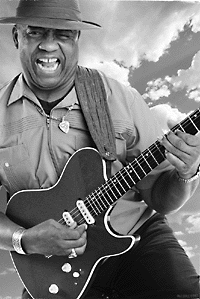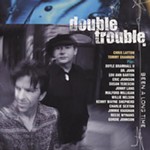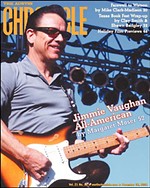Visions of This Town
Max Crace & the 1998 Austin Guitar Calendar
By Andy Langer, Fri., Nov. 21, 1997
|
|
As a highly successful commercial photographer and graphic artist, Max Crace is no stranger to deadlines. In his business, you're only as good as your reputation to consistently meet -- and preferably beat -- deadlines. More importantly, to miss a deadline is to miss a payday. "It's not unusual for me to go two or three days without sleeping," says Crace. "Only this time, I've set a new personal best -- six and a half days." Not only does Crace's latest project preclude sleep, there's no payday at the end; as photographer and designer of the 1998 Austin Guitar Calendar, the SIMS (Services Invested in Musician Support) Foundation's latest fundraising project, Crace is donating his time. And at this point in the process, Crace's contribution may be a lot more than he bargained for.
On the eve of his deadline for the calendar being sent to the printer, the local photographer is so tired he can hardly speak. Fortunately for Crace, however, his work speaks for itself, and it's already obvious that his sleep deprivation has resulted in a truly classic Austin-centric musical product: a 13-month calendar featuring 18 of this town's best-known and -loved musicians, including Willie Nelson, Eric Johnson, Tish Hinojosa, Ian Moore, Joe Ely, Sara Hickman, and Chris Duarte. In all cases, particularly with the Sexton portraits, Crace captures the expressions, poses, and attitudes that have come to be associated with these Austin artists. But then, this should come as no surprise.
As a photographer who regularly shoots some of the most well-known axe-slingers in rock & roll -- Johnson, Vai, Satriani -- for some of the most well-known guitar mags -- Guitar Player, Guitar World -- Crace is known within the industry as a consummate pro. In fact, you've probably seen Crace's work without even knowing it; his professional association with the notoriously camera-shy Johnson, for instance, stretches back over the local guitarist's three albums, and it's fair to say that many of the images the public has seen of Johnson over the years (including the Chronicle's cover story last year) were taken by Crace.
Not bad for a drummer.
|
|
While drumming for Wilks, Crace, like most local musicians, had to maintain a day-gig to pay the rent. When not on the road, then, Crace worked at the profession he'd been trained for -- graphic arts and illustration. Rather than merely helping local musician peers with their album cover art, however, Crace had a much more demanding client: The Department of Defense. Continuing a post-high school program in which the D.O.D. sent promising graphics students all over the world to illustrate military activity for federal exhibits that hang in the Smithsonian, Pentagon, and Air Force Academy, Crace continued the work he'd been doing for 10 long years.
By 1982, a book collecting military-themed work, Visions of Vietnam, earned Crace international praise and ultimately led to his work for Time-Life's "The Vietnam Experience" series. Yet around this time, almost in spite of his success as an illustrator, Crace began concentrating mostly on photography after a chance meeting in an art director's office. "I ran into a photographer and realized we'd both just done the same job and that he'd gotten the same money I'd gotten," says Crace. "Yet, he did a photo shoot in half a day, and I worked on an illustration for two and half weeks.
"So, in truth, my first foray into photography was purely mercenary in motivation. But I quickly got beyond that and really began digging the art form. I've always been really impatient, so although I have a knack for illustration, it's tortuous, because my style is naturally slow. Photography gives me a lot more instant gratification."
By 1984, the Wilks gig was becoming something less than gratifying, so it was with a stroke of luck that on Crace's last tour with the Austin guitarist -- a European jaunt with Golden Earring -- that he befriended the headlining band, and parlayed that relationship into an assignment for his first major-label album cover, the band's platinum-selling News album. The added bonus? A solo record deal with Golden Earring's European label, Ariola. Unfortunately, by the time Crace's album, under the Sierra Tango moniker, actually hit store shelves, the label had been sold twice, once to RCA and later to BMG.
"It was a pretty classic story," says Crace. "Nobody in the BMG A&R department knew who I was by the time they got it and the album failed, which is okay, because artistically it was also the classic case of trying to do what other people told me I should be doing. I was in way over my head. I'm a competent drummer, but I had no business trying to be a focal point."
Not that it was all for nothing. On the contrary. The most significant by-product of the Sierra Tango project was that Crace met his future wife Gay during the sessions for which she was called upon for backing vocals. And even though Sierra Tango was Crace's last dance with drumming up his own major label interest, he nevertheless spent the last two years working on a solo album for his wife. Recorded in a studio Crace built within his photography studio, his wife's album will feature guest appearances by Eric Johnson, Steve Barber, Tommy Shannon, Roscoe Beck, and Charlie Sexton.
Like hundreds of other artists, the aforementioned local musicians have also had their pictures taken at Crace's South Austin studio, where he's assembled a high-tech support system, including color processing, digital proofing, and an imaging work station for color separating and digital manipulation. And while it will come as no surprise that the money behind Crace's recording efforts and his graphic arts studio is not being financed by his musical efforts, it may come as a shock that neither is this all financed by shooting rock stars.
|
|
"It's funny," says Crace, "because a lot of people would look at my studio and business, and what I've done with my art and photography, and think that that in itself is a reasonable accomplishment. I'm fine with that and enjoy it, but in my heart all I ever wanted to do was music. So even though I've always done all types of commercial work for all different types of clients, I was always looking for every opportunity where I might be able to do something relating to music. I can do a perfectly serviceable job advertising a product, but it's different when I'm doing somebody's music project. It's a whole different thing emotionally."
It was no doubt the same emotional tug that dozens and dozens of local musicians, clubs, and music-related infrastructure businesses have felt over the course of this year that led Crace to volunteer his time and services to the 1998 Austin Guitar Calendar and its beneficiary, the SIMS foundation. A local non-profit group that provides mental health therapists for musicians in need of counseling, the SIMS foundation was formed in 1995 after the suicide of Pariah bassist Sims Ellison. Since that time, over 100 local musicians have taken advantage of the foundation's services, which is impressive given that the organization works on what could be charitably called a shoestring budget.
"Part of the original SIMS concept," explains Peyton Wimmer, a musician-turned-counselor and director of the foundation, "was to operate as bare bones as we could for two years and concentrate more on doing good work than just focusing on finding the money we needed. Rather than going around saying, `We've got this great idea,' I always figured it would more effective to wait it out and indicate what we're really capable of by showing some kind of track record instead."
Right in step with Wimmer's two-year plan to develop a reputation, 1997 has indeed become the SIMS Foundation's "Year of the Unsolicited Offer." First, in March, Wimmer got a call from Southwest Vintage Guitar owner Garrie Johnson, who not only came up with the idea for the calendar, but also the money for it -- as well as the proposal to have all its proceeds donated to the SIMS foundation. Not a bad payday for Wimmer's simply picking up the phone. Still, it was hardly the only offer received by the foundation; September brought an announcement from KGSR that the revenue generated by this year's installment of the station's popular Broadcasts CD would be also earmarked for SIMS Last year's CD, with a smaller production run than is planned for this year, earned $44,000 for a NARAS charity program.
And just last week, the final paperwork cleared on a grant from an East Texas group, the Cain Foundation, which plans on giving the local foundation $30,000. While some organizations fill out dozens of grant applications in hopes of landing just one endorsement half that large, this was again a case of an unsoliticited call coming in over the SIMS hotline. And it came just in time, according to Wimmer, who says that even at discounted rates, the costs of counseling were exceeding the foundation's budget. But add the Cain Foundation's grant to the expected dividends from the calendar, and the KGSR disc to the proceeds of the foundation's popular "Day in the Life" concert series, and '97 is shaping up as good year for SIMS
"For a while, I was going to be like the Hair Club guy -- both the president and a client," says Wimmer. "Trying to stay afloat was pretty stressful, but it looks like the good intentions we've been running on have caught on and multiplied."
Because the Cain Foundation's grant matches the SIMS Foundation's entire operating budget for the past two years, Wimmer says his organization will now be able to add to its ability to provide direct patient care, while beginning a community education program that should effectively shift SIMS from a reactive to proactive institution. "Until now, we've had to operate like a Band-Aid, stopping some of the bleeding," says Wimmer. "But the cycle itself doesn't necessarily stop when you help one person. For that kind of impact, you have to get out and educate the community as a whole with a broader program."
For his part, Crace says he's been particularly conscious of the foundation's need for good promotional vehicles mostly because before Johnson approached him with the calendar idea, he'd never heard of SIMS "I was actually completely unaware of SIMS," Crace says. "When Garrie told me about the project and said the money was going to SIMS I said, `What's that?' He told me, and I've been impressed ever since."
Without question, the photos in the 1998 Austin Guitar Calendar define the word "impressive." As an added bonus for the SIMS Foundation, Crace has also offered to print each one of the calendar's subjects on a three-foot museum-quality canvas, so that these prints, along with prints capturing several outtakes from the sessions, can be auctioned off this Friday during a party at Wild About Music, with all proceeds again benefiting SIMS.
And although Crace is picking up all the printing costs for the calendar's limited edition prints, the SIMS charity work makes for good practice towards the local photographer's long-term business goal: a repositioning of his studio toward the fine art prints market. To that end, Crace is looking forward to the January delivery of an Iris Printer, the industry's most expensive digital lithograph printer.
"In reality, despite the perceived boom here, the heyday or gravy train for the computer industry and its advertising is over," says Crace. "Because the clients themselves are making less money, they're placing smaller ads. What were once full-page, full-color accounts are now half-page black-and-white. Those can't cover my overhead, nor is it possible to finance a commercial graphic arts studio solely from music-related work. But that music work, shooting year after year, builds a back catalog of potentially great music images that could eventually take on historic value as prints. With the Iris, I not only make cost-effective prints of that work, but also eventually attempt to change my overall strategy... shooting, printing, and selling real art, as opposed to concentrating on the advertising work."
More immediately, Crace says he'll simply be thrilled if his efforts on the calendar and prints draw advertising-style attention to SIMS. Anyone who has ever faced a deadline knows how easy it is for nerves to fray no matter how good the finished product may be. But even on his sixth sleepless day, Crace is still visibly excited about the calendar and its potential for SIMS.
"It's been an amazing project," enthuses Crace. "I still can't get over the fact that a private citizen, Garrie, is willing to put this kind of money on the line. He's not wealthy by any means -- just a working guy -- and the best he can ever hope for is just to break even. Meanwhile, Whitley printing is doing the job for cost, which for a project this complex is truly substantial. I've been nothing but impressed with Peyton's support since this thing started... and then there's the musicians themselves.
"One of the great perks for me was just getting to sit and watch these guys play. Most of them, like Ian, Charlie, Chris, and W.C., weren't just holding the guitar as props, they were playing. They were performing, and I think it shows in a lot of the photos. This calendar is the story of this town's musicians -- no egos, no prima donnas, just a bunch of great players doing their part for a local cause we all believe in. And if Willie Nelson makes the time to do this, who are any of us to have an excuse? Projects don't get much better than this."










